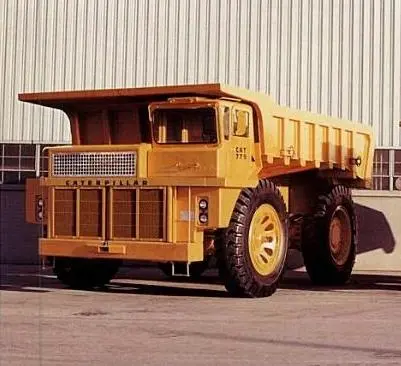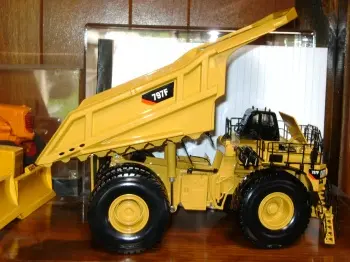Reply to SJ:
I think the one your talking about is a 769 truck and they came out in 1963 and were a 99F with a D343 engine in them. We had a lot of them here used in the coal strippings and other construction work.They were a toy by the side of the ones Cat makes now the 797 series and if I remember correctly they can haul around 400 tons. When I worked for a Cat dealer yet the 777 was the big one then but these bigger ones the 793 and 785 along with the 797 came out after I retired and I never saw them.
donl4- Cat designation for trucks commenced with the number "7" .. whereas the scraper line always commenced with the number "6". On that basis, your memory cells are playing tricks on you .. not uncommon at our advanced age .. 😄
Cat produced a range of experimental dump trucks in the early 1960's. The 769 was the first attempt by Cat to break into the dump truck market that was dominated by other manufacturers.
The 769 project actually commenced in 1956. In that year, Cat commissioned a study of all haul trucks on the market, looking for a suitable entry point for a Cat truck.
At the completion of this study, a concept hauler project, based on a 28-ton load capacity was initiated, and the prototype 769X1 was completed in 1959. The odd-looking 769X1 was fitted with extra-large single rear tires (shades of Euclid? 😄 ).
Prototype 769X2 was built with a solid rear end (i.e. - no suspension) in the hope that the extra-large tires would provide adequate suspension for a comfortable ride. They didn't. Cat abandoned the idea.
Prototype 769X3 was built along the lines of the final production 769 .. with the load capacity increased to 35 tons, to keep up with competitors new sizes. It had dual rear tires and rear suspension.
Prototype 769X4 was essentially the forerunner of production 769's, with all the basic design sorted out. Important design features were the independent, pneumatic/oil suspension units, oil-cooled disc brakes on the rear axle, a modern OHC D343 engine producing 375HP, and powershift transmission.
As a matter of great historical interest, Cats head of dump truck design and production at this point just happened to be one Ralph H. Kress .. former manager of truck development at Le Tourneau-Westinghouse, and designer of the first Haulpak trucks.
Kress was head-hunted and given the position of manager of truck development, for the Research and Engineering Dept at Caterpillar.
Kress's considerable ability and impact was obvious when Cat management initiated a study into larger haul truck models, and decided on a diesel-electric-drive, 75 ton model, as the next product after the 769.
This truck, known as the 779, was produced as a prototype in 1965 .. along with two other diesel-electric-drive models, the 783 & 786. The prototype 779 was delivered to Cleveland Cliffs Iron Co, Republic mine, at Marquette, MI in late 1965 for gruelling on-site testing. In Oct 1966, Cat management gave the go-ahead for full production of the 779.
The early production model 779's were full of major design faults. The chassis in the 779 used high tensile steel, whereas the 769 used mild steel. The chassis of the 779 was prone to cracking within a short amount of hours worked. Repair of the specialty high tensile steel under mine-site conditions was difficult, and the repairs were usually unsatisfactory.
Cat promptly redesigned the chassis, adding a lot more steel, and the improved design was officially released for public sale in July 1967.
Initially a 75 ton design, the load capacity was uprated to 85 tons in 1968 after further design improvements.
The 779 was a disaster. The frame still cracked, even after redesign .. the electric drive was a constant source of problems .. and the highly sophisticated (read, complex) pneumatic-oil suspension system was also full of problems.
Finally, Cat had had enough. In May 1969, production of the 779 was ceased, after a total of 41, 779's had been built. To eliminate further warranty claims and costs to Cat, all 41 trucks were repurchased by Cat, and destroyed by dismantling. Not a single 779 survives.
This must have been a very expensive exercise for Cat, and obviously turned Cat management against electric drive for nearly 4 decades. Cat turned back to mechanical drive, and touted it as the less-costly and simpler-to-maintain system, for almost the next 40 years .. with virtually every Cat truck brochure in that period, sneering at the cost and complexity of electric drive .. in any form.
Interestingly, in the last 10 years, Cat have grudgingly come to accept that electric drive does have a lot of advantages, if properly designed .. particularly in the larger machines. The new electric-drive D7E is one of a new line of Cats that will most certainly mean that a lot more Cats in the future will boast electric drive.
Don, I can't really help you with ID of your mystery truck .. but perhaps the 779 was the model you recall seeing, as it was one of the largest Cat dump trucks produced in the 1960's, and was the model that actually saw production. There were other experimental Cat haul truck designs in that era, but it appears that few left the Cat proving grounds, and many were one-offs.
Here is pic of the 779, courtesy of Eric Orlemanns "Caterpillar Chronicle". The pic shows the truck with only the outside rear tires fitted, as this was the way they were transported.



